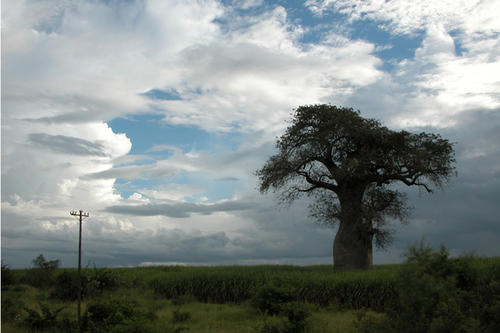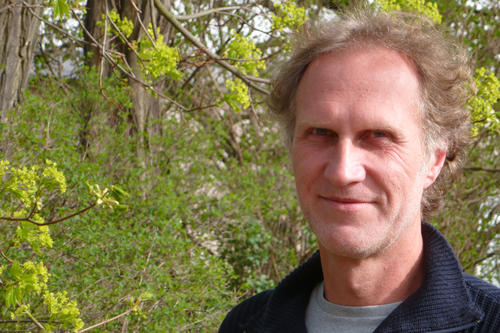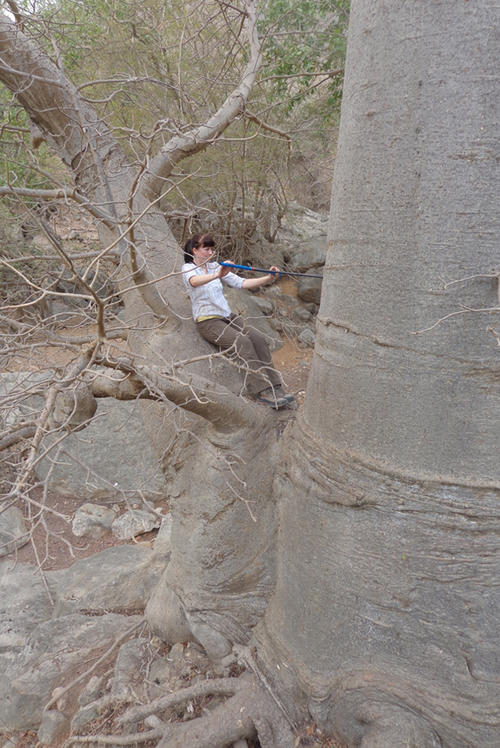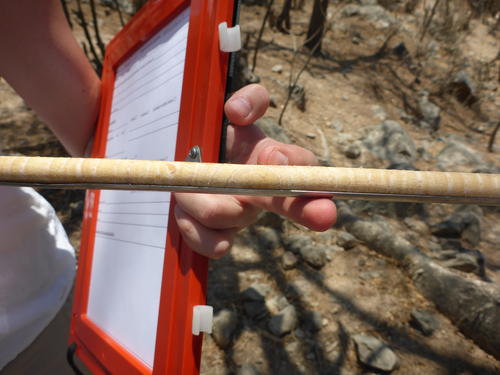Important Witnesses to Climate Change
What baobab trees tell us about the Earth’s climate is the subject of research for paleobiologist Frank Riedel and his team
Sep 07, 2015
Baobab trees, like this one in Malawi, can live as long as 2,000 years, making them an important source of data for climate research.
Image Credit: Alex Antener (Lix) /wikicommons, CC BY SA 3.0
Paleobiologist Frank Riedel often travels to southern Africa and Oman for his research.
Image Credit: Lennart Paul
Franziska Slotta, a research associate working with Frank Riedel, prepares to take a core sample from a baobab tree.
Image Credit: Frank Riedel
The result: a core sample that the scientists can use as an archive to reconstruct the climate in centuries past
Image Credit: Frank Riedel
They tell us about the past, and they hold important information for our future. The mighty baobab trees of tropical Africa can offer insight into how the climate has developed. Frank Riedel, a paleobiologist at the Department of Earth Sciences, studies the giant trees with a group of colleagues.
It is a journey into centuries past. When Frank Riedel sets off and flies to Namibia, Botswana, South Africa, or Oman, drives to the baobab trees with a team of researchers, puts the corer in place and then, in a strenuous joint effort, drills deep into the heart of the trunk and finally pulls out a piece of wood that looks like a long pencil – then he can see as much as 1,000 years of tree rings.
Have Droughts Grown Longer in the Course of Different Eras?
Riedel can use the samples to see various things, such as how much the trees grew during past rainy seasons. He can trace how much precipitation there must have been, what kinds of dry periods there must have been, and whether droughts grew longer in the course of different eras. “Baobabs work like cacti,” Riedel says. “They can store water, so they can survive even long periods of drought,” he adds.
One factor Riedel finds useful for his research work is that he feels right at home in multiple scientific disciplines. “Even back when I was in school, I was always a person with broad interests,” says Riedel, now 53. Sometimes he perceived that as an obstacle, but generally it was an advantage. He says it was not easy for him to decide on a single profession.
After graduating from secondary school, Riedel’s first step was to go to sea with the German navy. The then 18-year-old wanted to see the world, but in the end, he ended up seldom moving beyond the North Sea and Baltic Sea during his time in the navy. Riedel still longed to travel to far-off lands, but after about four years with the navy, he first needed to find the right study program for him. It was then that he decided to combine at least two of his interests: geology and biology.
Combining Geology and Biology
During courses in subjects such as microbiology, Riedel realized that he did not want to spend most of his working life in a lab. “But I had also become aware that I wanted to work on an interdisciplinary basis,” he recalls. It was an aim he pursued consistently throughout the rest of his academic career. At Universität Hamburg, he wrote his dissertation at the Department of Earth Sciences, only to defend it afterward at the Department of Biology.
In January 2001, Freie Universität Berlin offered Riedel a position at the Department of Earth Sciences in Lankwitz – and the professor brought his own discipline, paleobiology, along with him. He says he is not only interested in studying and teaching about historical biology. “Research on fossils yields a very spotty picture of the past, since not very many life forms are preserved in the fossil record,” he points out. With this in mind, his approach – and that of some of his colleagues – is to use recent species, meaning those that are still living or recently became extinct, to draw conclusions about evolutionary history.
An Important Facet of Research on Climate Change
Is paleobiology a backward-looking science? By no means, as the baobab project shows. Riedel and his colleagues Gerd Helle, of the German Research Centre for Geosciences (GFZ) in Potsdam, and Uwe Heussner, of the German Archaeological Institute (DAI), aim to add an important facet to the research findings generated by mathematicians, physicists, and meteorologists, which currently dominate the debate surrounding climate change. “Meteorologists can only go back 130 to 140 years in their observations,” Riedel says. “That’s much too short a period for studying long-term climate patterns,” he adds.
For example, major droughts may occur in southern Africa about every 70 years, so Riedel points out that the meteorological record includes only one instance of this kind of event. “That’s not a pattern yet, of course. It doesn’t tell you anything about whether droughts really occur regularly or what is behind them,” Riedel says. Current climate models, he says, do not rely on sufficient data, so they are heavily prone to errors. “But,” he continues, “these models are the basis for policies to protect the climate.”
Trees Live as Long as 2,000 Years
Since being appointed to his position at Freie Universität Berlin, Riedel has been working on determining which natural “climate archives” stretch back far into the past, but can also show climate variability within a year or even a single season. In 2010 Riedel discovered baobab trees for his research due to a number of factors, including because a colleague had shown that the legendary African trees can live as long as 2,000 years.
Baobab trees shrink during dry periods and swell during rainy ones. These differences can be traced over the centuries using dendochronological methods that include isotope geochemistry.
Riedel regularly travels through southern Africa for his research. But there are also baobab trees in the mountains of Oman’s Dhofar region because the monsoon rains reach this area. “These specific areas around the margins of a climate zone are the best place to see changes,” he says.
Collecting Data by Coring Trees on Site
In all of the countries, the German climate researchers work together with local partners. These partners also help to make contact with village and rural communities and explain to them why the researchers want to take core samples from centuries-old baobab trees in their area.
If Riedel and his colleagues are successful in their work, there will soon be a climate archive for southern Africa. At that point, it will not only be possible to make statements about developments over the past few centuries, but also to trace regional changes. “Climate change does not take place evenly everywhere, of course,” Riedel says. “Looking at every region separately is highly labor-intensive, but it is the only way to live up to the standard of giving people a serious forecast about their area’s future climate.”
Further Information
Prof. Dr. Frank Riedel, Geologische Wissenschaften, Fachrichtung Paläontologie, Tel.: +49 30 838 70283, E-Mail: paleobio@zedat.fu-berlin.de




